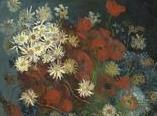Detail of the colour photograph of Still life with meadow flowers and roses (© Kröller-Müller Museum)
After lengthy research the Kröller-Müller Museum has another Van Gogh painting to its name: Still life with meadow flowers and roses. Its authenticity had been in doubt ever since it was added to the collection in 1974, due to the unusual size of the canvas and the anomalous signature among other things. The work was dismissed in 2003 and has been listed as “artist: anonymous” ever since.
Now, nine years later, a team of researchers from the TU Delft, the University of Antwerp, Deutsches Elektronen-Synchrotron DESY in Hamburg, the Van Gogh Museum and the Kröller-Müller Museum has succeeded in confirming its authenticity.
The results are now presented in the article “Rehabilitation of a flower still life in the Kröller-Müller Museum and a lost Antwerp painting by Van Gogh”, a prepublication of "Van Gogh Studies 4". From today, for the first time in its history, the flower piece will be given a prominent position among other works by Vincent van Gogh in the museum’s collection.
An X-ray image made in 1998 already revealed that the flower piece was painted over the other depiction: the scene with the torsos of two wrestlers grasping each other by the arms. This X-ray continued to fascinate researchers. The new research technique MA-XRF (Macro Scanning X-ray Fluorescence Spectrometry) made it possible to analyze both paintings in greater detail.
The experiments which were mainly conducted at DESY´s synchrotron radiation source DORIS in Hamburg revealed not only a defining characteristic of the academy in Antwerp, namely that the male models posed half naked in contrast to academies elsewhere, but that the pigments used correspond entirely with Van Gogh’s palette at that time. Furthermore, it was also possible to recognize Van Gogh’s typical brushstrokes in the now far more visible depiction.
(from DESY press release)
| Further Links |








